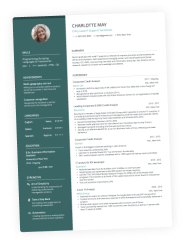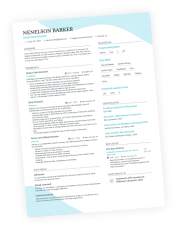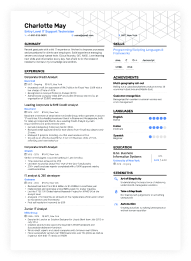Have you ever wondered if AI can write a better resume than you—or if recruiters can instantly spot a robot-written one?
Artificial intelligence is rapidly changing how people search for jobs—and its impact extends to resume writing, too. From AI-generated bullet points to tools that tailor your resume to a specific job description, more job seekers are using AI to save time and boost their chances.
But with so many AI tools promising faster results andbetter chances of passing applicant tracking systems (ATS) scans, it’s fair to ask: Can they really write a good resume?
This article breaks down how AI resume builders work, what they can and can’t do, and how to use them strategically—without losing your personal voice.
Key takeaways
- AI for resume writing can save time, improve formatting, and help with keyword optimization.
- AI tools work best as a starting point—not a final product.
- Recruiters can often tell when content is AI-generated and expect personalization.
- Effective use means adding real metrics and tailoring your resume to each job.
- AI resume builders like Enhancv help you craft a personalized resume with intelligent guidance—while keeping full control over the process.
Upload and check your resume to instantly evaluate it for ATS compatibility.
Is your resume good enough?
Drop your resume here or choose a file. PDF & DOCX only. Max 2MB file size.
Can AI create a resume?
Yes, it can. Modern AI resume builders are designed to streamline the writing process, saving you time and helping you tailor your resume more effectively. With just a few prompts, AI can generate content, suggest role-specific bullet points, and even optimize formatting for applicant tracking systems (ATS).
The key is using it as a tool—not a replacement—for your expertise and experience.
What are AI resume builders?
AI resume builders are digital platforms that use artificial intelligence—typically natural language processing (NLP) and machine learning—to help you write and improve your resume.
These tools respond to the information you enter. They can suggest content, adjust formatting, recommend keywords from job descriptions, and help tailor your resume for specific roles—all in real-time.
Many platforms go a step further by identifying relevant keywords from job postings, generating summaries, and formatting your resume for ATS compatibility.
AI resume builders, like Enhancv, guide you through each section with suggestions tailored to your role and industry.
PRO TIP
Use AI for structure and inspiration, but always personalize the content. Your resume should reflect your real achievements—not just what sounds professional.
Understanding how AI resume builders work sets the stage for exploring the key advantages they offer to anyone looking to create a stronger, more competitive resume.
Benefits of using AI for resume writing
Using AI for writing a resume offers a range of benefits, especially for people who need to apply for jobs quickly or aren’t sure where to begin. Though not perfect, AI can save time, simplify formatting, and improve your chances of getting past an applicant tracking system.
Here are some of the top advantages:
- Time-saving and efficient: AI can generate content in seconds, allowing you to create or revise a resume in a fraction of the time it might take manually. This is especially helpful when applying for multiple jobs or exploring different industries.
- Keyword optimization for ATS: Many AI tools scan job descriptions and identify relevant keywords and skills to repeat on your resume. This boosts your chances of passing ATS filters and reaching a recruiter’s inbox.
- Clean structure and professional formatting: AI builders use templates that ensure your resume is easy to read and correctly formatted. This helps avoid common issues like inconsistent spacing, unclear section headers, or distracting designs.
Last but not least, it’s cost-effective for budget-conscious job seekers. Professional resume writers and coaches can provide valuable support, but their services often come at a high price. AI resume tools offer a more accessible alternative for those looking for guidance without the added expense.
Limitations and concerns of AI for writing a resume
Despite its advantages, AI isn’t failproof. Over-relying on automation can lead to missed opportunities—or even raise red flags with hiring managers.
Here are some of the common limitations to keep in mind:
- Generic or vague content: AI-generated resumes often produce generic bullet points that fail to reflect your specific accomplishments. If you don’t personalize the output, your resume can end up sounding like everyone else’s.
- Loss of authenticity: Recruiters value individuality. A resume that lacks your voice or fails to convey your unique career story may feel flat or insincere. It’s important to revise AI-generated content so it reflects how you think and work.
- Recognizable AI language: Certain words or phrases—like “delve,” “synergy,” or “proven track record”—are often giveaways that AI was used. Hiring managers and recruiters can usually spot when the content hasn’t been tailored or reviewed by a real person.
- Privacy and data concerns: AI resume tools often require you to input personal data, such as your work history and contact information. It’s important to review the privacy policy of any platform before uploading sensitive information.
AI can be a powerful assistant—but it’s not a substitute for your judgment, voice, or strategy. Use it wisely, and always take the time to refine the final result.
Recruiter and hiring manager perspectives
AI might help you get started, but it's the human touch that makes your resume stand out. Recruiters and hiring managers review hundreds of applications—and many say they can easily spot when a resume is written entirely by AI.
- AI is easy to detect: Hiring managers often notice when resumes use generic, repetitive, or irrelevant phrases. These red flags suggest that the content wasn’t written with care—or wasn’t tailored to the role. Other common signs include vague accomplishments, robotic tone, and overused buzzwords.
- Personalization matters: Recruiters look for clear indicators that you understand the role and have experience that matches the company’s needs. Specific, personalized details—like metrics, tools used, and project outcomes—go a long way in setting you apart. AI might generate a framework, but can’t replace real insight or career context.
- How ATS plays a role: Many employers use AI scanners to check resumes before they ever reach a human. These systems search for job-specific keywords, structured formats, and clearly labeled sections. While AI tools can help optimize for ATS, recruiters still expect a readable and relevant resume once it passes through the filter.
Ultimately, recruiters aren’t opposed to AI—what matters is how you use it. The best resumes show effort, clarity, and intent, regardless of whether they started with a prompt or a blank page.
Best practices when using AI to write your resume
AI can be a great starting point, but it’s most effective when paired with your own input, edits, and strategy. Think of it as a tool to support your process—not replace it.
Get the most out of AI resume writing tools
- Use AI as a first draft, not a final version: Let the tool generate structure, bullet points, or phrasing suggestions—but always review and revise. Emphasize your own voice, achievements, and career context to make the resume truly yours.
- Add measurable results: AI can’t pull in the numbers unless you give them. Go back and insert quantifiable achievements (e.g., “increased customer satisfaction by 18%”) to demonstrate impact.
- Be specific with prompts: To get better output from tools like ChatGPT, provide clear and detailed instructions. Include your role, responsibilities, outcomes, and the job description you’re targeting. The more specific you are, the more relevant the results.
- Avoid the “copy-paste” temptation: Recruiters can tell when you’ve pasted generic AI-generated content. Treat the AI’s suggestions like a rough sketch—your job is to refine them into something polished and personal.
Used well, AI can cut your writing time in half. But it's your knowledge and experience that turn a decent resume into a great one.
Common ATS myths and AI resume 'hacks'
One reason people turn to AI resume tools is to improve their chances of getting past applicant tracking systems—software that scans resumes for keywords, structure, and relevance before a human ever sees them. But this has also led to a wave of misinformation and so-called “hacks” meant to trick the system.
Let’s clear up some of the most common ATS myths—and explain what actually works when you're using AI to write or refine your resume.
Popular myths—what not to do
- Myth: Hiding keywords in white text helps you beat the ATS.
Reality: Most ATS software either ignores or flags this as manipulation. Recruiters will see the hidden text and it can backfire. - Myth: You should always submit your resume as a Word doc.
Reality: Submit your resume in whatever format the employer requests. Modern ATS can read both PDFs and Word documents—just don’t ignore the instructions. - Myth: Stuffing keywords into your resume is the fastest way to get noticed.
Reality: Keyword stuffing makes your resume unreadable and looks suspicious to both ATS and recruiters.
What actually works
- Use clear, standard section headers: Stick with widely accepted headings like Skills, Experience, Education, or Technical Proficiencies so the ATS can find the right information.
- Choose a clean layout: Avoid tables or too many graphics. These can confuse ATS parsing and hide your most important content.
- Mirror the job description (honestly): Pull keywords from the job posting—but only use those that match your actual skills and experience. Phrase them naturally within your achievements and responsibilities.
- Stick to text, not tricks: Decorative visual elements can sometimes affect parsing in older ATS systems. Simplicity increases your chances of both passing the ATS and impressing a human reader.
Looking for a layout that works? Traditional resume templates provide clean formatting that’s ideal for ATS and easy for AI tools to build on.
AI can boost your resume’s chances with ATS software, and it’s also being used in another area many applicants find challenging: writing cover letters.
Can AI write a cover letter? Here’s how to make it work
AI isn’t just being used to generate resumes—it can also help you write cover letters. From drafting opening lines to structuring your message, tools like ChatGPT can speed up the process and offer a helpful starting point. But just like with resumes, you shouldn’t rely on AI to do the whole job for you.
Used wisely, AI can help you:
- Get past writer’s block: Struggling to start? You can prompt AI with your role, the company name, and what excites you about the job to get a workable draft.
- Add structure: AI can organize your ideas into a professional format with a clear opening, body, and closing paragraph.
- Tailor your message: When given the job description and context (like a career switch or employment gap), AI can help you phrase your story more effectively.
Even a short, AI-assisted cover letter can add value—but only if it feels authentic.
After generating a draft:
- Edit the tone so it sounds like you, not a chatbot.
- Add personal touches like why you’re genuinely excited about the company or role.
- Avoid fluff and focus on specific ways you can contribute.
AI can help you start strong—but you’re the one who should finish it.
For an easier starting point, the Enhancv Cover Letter Builder can guide you through the process step by step—so you stay in control while getting the structure and support you need.
Conclusion
AI can absolutely support your resume writing process—but it’s not a set-it-and-forget-it solution. Used well, it can save time, improve structure, and help you speak the language of applicant tracking systems. But the best resumes still require a human touch: personalized details, real achievements, and thoughtful customization.
Whether you're using a free AI resume builder or tools like ChatGPT, remember this: AI can draft, polish, and suggest—but you bring the experience and intent. The most successful resumes are a collaboration between smart tools and self-awareness.
Let AI do the heavy lifting—but make sure your voice still comes through.
Use the Enhancv Resume Scanner to instantly check your resume’s ATS compatibility and see how you can improve it.
Is your resume good enough?
Drop your resume here or choose a file. PDF & DOCX only. Max 2MB file size.
Make one that's truly you.



